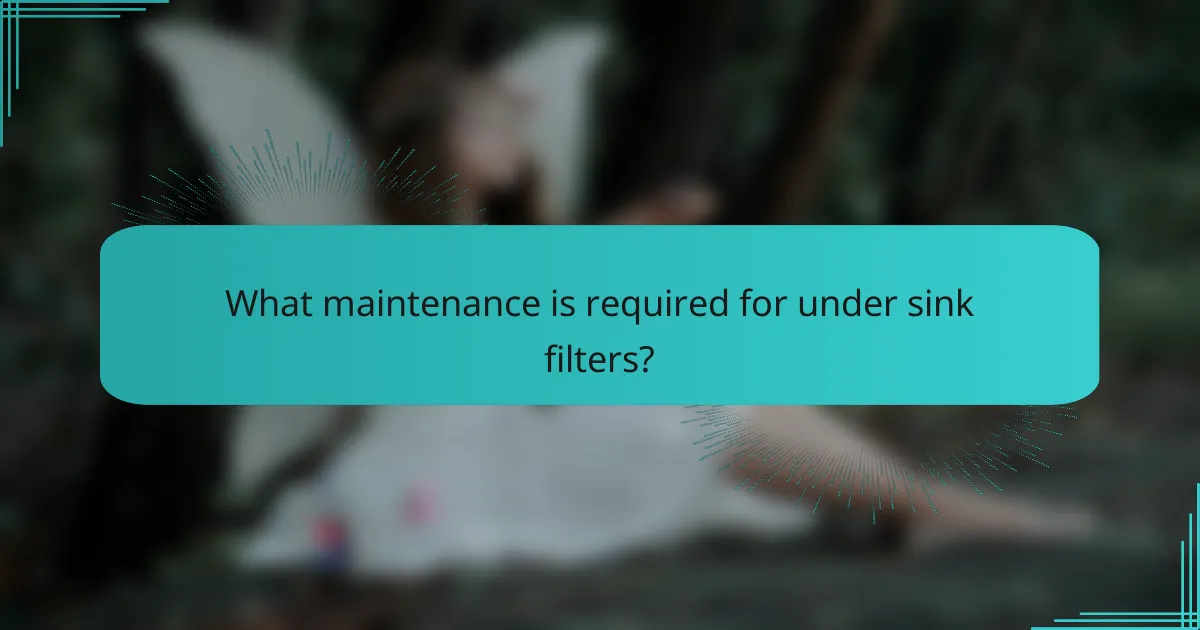Under sink filters offer a space-saving solution for accessing clean drinking water directly from your plumbing system. Designed to fit neatly beneath your kitchen sink, these filters efficiently purify water while maximizing your kitchen’s layout, making them a cost-effective choice for households seeking convenience and quality.

What are the benefits of under sink filters in the UK?
Under sink filters in the UK provide a practical solution for accessing clean drinking water while maximizing space. They are designed to fit neatly under your kitchen sink, offering convenience and efficiency without compromising your kitchen’s layout.
Space-saving design
The compact nature of under sink filters allows them to be installed discreetly beneath your sink, freeing up valuable counter space. This design is particularly beneficial in smaller kitchens where every inch counts.
Many models are designed to fit standard sink cabinets, making installation straightforward. Ensure you measure the space available to choose a filter that fits comfortably without interfering with plumbing or storage.
Direct access to filtered water
Under sink filters provide immediate access to filtered water through a dedicated tap, eliminating the need for bulky pitchers or countertop units. This setup encourages regular consumption of clean water, promoting healthier hydration habits.
Some systems even allow for instant access to hot or cold filtered water, enhancing convenience for cooking and beverage preparation. Consider models that offer multi-temperature options for added versatility.
Cost-effective solution
Investing in an under sink filter can lead to significant savings over time compared to buying bottled water. The initial cost of the filter can be recouped within months through reduced spending on bottled water.
Additionally, many filters have replaceable cartridges that last several months, further lowering ongoing costs. Regular maintenance is essential to ensure optimal performance and longevity of the system, so factor in the cost of replacement filters when budgeting.

How do under sink filters work?
Under sink filters provide a convenient way to purify water directly from your plumbing system. They typically use a combination of physical and chemical processes to remove contaminants, ensuring clean drinking water without taking up counter space.
Filtration process overview
The filtration process in under sink systems generally involves several stages. Water flows through a series of filters that may include sediment filters, activated carbon filters, and sometimes reverse osmosis membranes. Each stage targets specific contaminants, such as chlorine, heavy metals, and microorganisms.
After passing through the filters, the purified water is stored in a small tank and dispensed through a dedicated faucet. This setup allows for continuous access to clean water while minimizing the need for bottled water.
Types of filtration systems
There are several types of under sink filtration systems available, each suited for different needs. Common types include activated carbon filters, which are effective at removing chlorine and improving taste, and reverse osmosis systems, which can eliminate a broader range of contaminants, including heavy metals and salts.
When selecting a system, consider factors such as the contaminants present in your water supply, the filtration capacity, and maintenance requirements. For example, reverse osmosis systems typically require more frequent filter changes and may waste some water during the filtration process.

What are the best under sink filters available in the UK?
The best under sink filters in the UK provide efficient water purification while saving space and offering direct access to clean water. Key options include the Brita, Waterdrop, and iSpring filters, each with unique features and benefits tailored to various needs.
Brita Under Sink Filter
The Brita Under Sink Filter is designed for easy installation and effective filtration, removing chlorine, sediment, and other impurities from your tap water. It typically uses a multi-stage filtration process, ensuring that you enjoy cleaner, better-tasting water.
Consider the Brita model if you value a compact design and straightforward maintenance. Replacement filters are readily available, making it a convenient choice for households looking for a reliable solution.
Waterdrop Under Sink Filter
The Waterdrop Under Sink Filter stands out for its advanced filtration technology, which includes a reverse osmosis system that can remove a wide range of contaminants, including heavy metals and bacteria. This filter is particularly suitable for those concerned about water quality.
Installation is user-friendly, and the filter’s compact size allows it to fit easily under most sinks. Regular filter replacements are necessary, but the long lifespan of the filters can make it a cost-effective option in the long run.
iSpring Under Sink Filter
The iSpring Under Sink Filter offers a robust filtration system that combines multiple stages, including sediment and carbon filters, to ensure high-quality water. This system is effective at reducing chlorine, lead, and other harmful substances.
With a focus on durability and performance, the iSpring filter is ideal for families looking for a long-term solution. It’s essential to monitor filter life and replace them as recommended to maintain optimal performance and water quality.

How to choose the right under sink filter?
Choosing the right under sink filter involves assessing your water quality, understanding filter lifespan, and evaluating installation requirements. These factors will help you select a filter that meets your needs while ensuring efficient and effective water purification.
Consider water quality
Start by testing your water to identify contaminants such as chlorine, lead, or sediment. Many filters are designed to target specific impurities, so knowing what’s in your water will guide your selection.
For instance, if your water has high levels of chlorine, a carbon filter may be effective. Conversely, if lead is a concern, look for filters certified to remove heavy metals.
Evaluate filter lifespan
Filter lifespan varies significantly among models, typically ranging from six months to several years depending on usage and water quality. Check the manufacturer’s specifications for replacement intervals to avoid reduced performance.
Consider your household’s water consumption when evaluating lifespan; larger families may need to replace filters more frequently than smaller households.
Assess installation requirements
Installation complexity can differ widely between under sink filters. Some systems require professional installation, while others are designed for DIY setup with minimal tools.
Before purchasing, review the installation instructions and ensure you have the necessary space under your sink. Additionally, check if you need any plumbing modifications, which could incur extra costs.

What are the installation steps for under sink filters?
Installing an under sink filter involves a few straightforward steps that ensure a secure and efficient setup. This type of filter provides direct access to clean water while saving space, making it a cost-effective solution for households.
Step 1: Gather necessary tools
Before starting the installation, collect all the necessary tools to ensure a smooth process. Common tools include a wrench, screwdriver, and Teflon tape. Having these items on hand will help avoid interruptions during the installation.
Additionally, check if the filter kit includes any specific tools or components required for installation. Familiarizing yourself with the parts will make the setup easier.
Step 2: Shut off water supply
To prevent any leaks or water damage, turn off the water supply before beginning the installation. Locate the shut-off valve under the sink and turn it clockwise until it is fully closed.
After shutting off the water, open the faucet to relieve any pressure in the lines. This step ensures a safer installation process and minimizes the risk of water spraying during the setup.
Step 3: Install the filter unit
Begin the installation by following the manufacturer’s instructions for your specific under sink filter model. Typically, you will need to connect the filter unit to the water supply line using the provided fittings.
Ensure all connections are tight to prevent leaks. After securing the filter, turn the water supply back on slowly and check for any leaks around the connections. If everything is secure, you can then test the filter by running water through it for a few minutes to ensure proper functionality.

What maintenance is required for under sink filters?
Under sink filters require regular maintenance to ensure optimal performance and water quality. This typically involves changing the filter cartridges and cleaning the system periodically to prevent buildup and contamination.
Regular filter replacement
Regular filter replacement is crucial for maintaining the effectiveness of under sink filters. Most filters need to be changed every six months to two years, depending on usage and water quality. Check the manufacturer’s guidelines for specific recommendations.
To make filter replacement easier, consider using filters with a clear indicator showing when they need changing. This can help avoid the common pitfall of forgetting to replace filters on time, which can lead to decreased water quality.
Cleaning the system
Cleaning the under sink filter system helps prevent clogs and ensures efficient operation. It’s advisable to clean the system every few months, focusing on the housing and any accessible components.
Use a mild soap solution and a soft cloth to wipe down the exterior and any removable parts. Avoid harsh chemicals that could damage the system. Regular cleaning can extend the lifespan of your filter and maintain high water quality.


